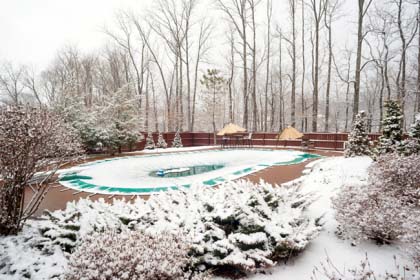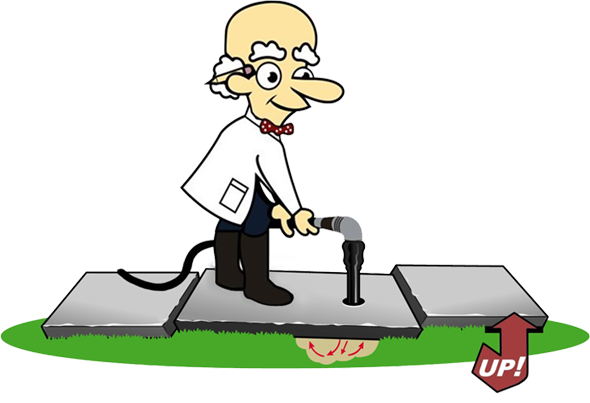IN THIS ARTICLE
 Just like the other parts of your home, in-ground concrete pools require regular maintenance; this is especially true during the harsher winter months. Failure to maintain your pool could result in cracks, hollow spots, or a raised pool. Given that at best it can cost as much as $60 per linear foot to have a professional repair cracked plaster or concrete in your pool, and at worse it can cost well into the thousands to replace one, it’s best to prevent these items from becoming an issue.
Just like the other parts of your home, in-ground concrete pools require regular maintenance; this is especially true during the harsher winter months. Failure to maintain your pool could result in cracks, hollow spots, or a raised pool. Given that at best it can cost as much as $60 per linear foot to have a professional repair cracked plaster or concrete in your pool, and at worse it can cost well into the thousands to replace one, it’s best to prevent these items from becoming an issue.
The best way to protect your pool during the winter is to winterize it. Here is how to winterize your in-ground concrete pool in six easy steps.
Step 1 – Balance the Water Chemistry
Before going into the actual steps, it’s important that you adjust the pH level of your pool’s water along with calcium hardness and alkalinity. The best practice would be to do it several days before cleaning the pool to allow sufficient time for the process to take place. You may do this by shocking the pool using granular chlorine, and doing so one week prior would ensure the chlorine levels drop before you go on to put in the pool cover.
Step 2 – Lowering the Water Level
Once you’ve thoroughly cleaned the pool of any algae are debris, it’s now time to lower the pool water. Important: Do not allow all of the water to escape, as the sudden lack of pressure could cause severe damage to the pool. The ideal level should be below the mouth of the skimmers as it allows the water to pass out of the throat of the skimmer, which would otherwise get damaged if water were left there to freeze. If you’ve got an inground vinyl liner, feel free to use a product known as an Aquador skimmer cover, which functions like your skimmer’s Tupperware.
Just snap this in front, and you shouldn’t need to lower the water level.
Step 3 – Add the Necessary Chemicals to the Pool
A standard pool closing kit contains substances such as borate floaters, algaecide, stain & scale as well as some non-chlorine shock. If you are using such a kit, be sure to follow the instructions on the package carefully as they often recommend adding the chemicals before lowering the level of pool water. Just spread the chemicals over the pool’s surface and use a pool brush to distribute it evenly.
If you have a mesh safety cover, using pool enzyme can also help in controlling algae growth over the winter season. It contributes to check the water chemistry in the spring as well as add another quart of Algaecide.
Step 4 – Thoroughly Cleaning the Pool Filter
The DE powder, if left to dry on the grades over the winter can lead to clogging of the fabric that would inevitably cause problems with your filtration system the very next spring. For DE filters, it’s important that you detach the assembly from the filter tank and hose it clean to remove all DE powder. After you’re done, reassemble the cartridge back into the tank for proper safekeeping over the winter.
Step 5 – Blowing the Lines
Blowing the lines is perhaps the most important step of the entire process. Thoroughly blowing the plumbing portions and other equipment ensures no water is left behind to cause freeze damage.
Once you’re done blowing, plug the skimmers, cleaner, and returns lines using expansion or freeze plugs. Be sure to fill them all.
Step 6 – Use Skimmer Bottles as a Precaution
Last but not least, you can make use of a Gizmo, which is essentially a combination of skimmer plug and a device for ice absorption. If you decide to plug the skimmers with rubber freeze plugs, then use a 1-gallon bottle that is empty for the most part apart from having small pebbles or antifreeze; this will help weigh the bottle down and partially remain submerged as well.
When the water rises to the skimmers level and freezes, the ice expansion will lead to the bottle collapsing instead of outside walls of the skimmer.
Keep these points in mind, and you should be able to prevent concrete damage in the winter so that you aren’t having to wrestle with a massive concrete repair bill this spring. However, if your pool does experience concrete damage Concrete Chiropractor is here to help, contact us today at 908-369-3110.
- Mudjacking Cost: 5 Factors That Affect It - April 10, 2024
- What is The Average Cost of Concrete Leveling in Belle Mead, NJ? - April 4, 2024
- Unveiling the Top Pool Deck Resurfacing Options: Choosing the Best for You - March 26, 2024


